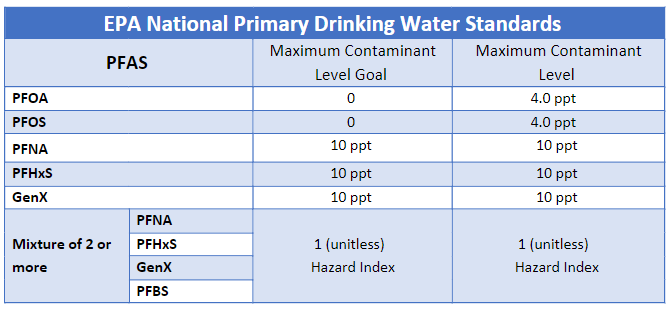EPA National Primary Drinking Water Regulation
On April 10, 2024, EPA established these Maximum Contaminant Levels (MCLs) and Maximum Contaminant Level Goals (MCLGs) for PFAS in drinking water.
On May 13, 2025, EPA announced changes to the National Primary Drinking Water Regulations (NPDWR) and the Maximum Contaminant Levels (MCLs) for PFAS. EPA announced it will keep the MCLs of 4 parts per trillion (ppt) for PFOA and PFOS that were established in April 2024; however, EPA intends to rescind the regulations for PFHxS, PFNA, HFPO-DA (commonly known as GenX), and the Hazard Index mixture of these three compounds plus PFBS. EPA will provide additional time for MCL compliance, including a proposal to extend the compliance date from 2029 to 2031. EPA plans to issue a proposed rule this fall and finalize this rule in the Spring of 2026.
See the announcement: EPA Announces It Will Keep Maximum Contaminant Levels for PFOA, PFOS | US EPA
Information about the national PFAS MCLs is available on the EPA webpage.
Establishment of MCLs requires EPA to take into consideration costs, benefits, feasibility, and public comments. MassDEP looks forward to engaging with EPA and to communicating with the public and with public water systems to help them understand what actions are being taken.
The establishment of an MCL for likely carcinogens (PFOS and PFOA) requires that EPA set the level as close as feasible to the health-based Maximum Contaminant Level Goal of zero for PFOS and PFOA.
MassDEP Plan for PFAS regulations
States are required to establish regulations that are no less stringent than the federal standards within two years of the promulgation of the federal MCL, with the possibility of an extension of up to two years. MassDEP will be proposing amendments to its PFAS regulations to be at least as stringent as the EPA MCLs and will be holding public hearings to receive public input on this proposal.
The EPA MCLs are applicable to Community (COM) and Non-Transient Non-Community (NTNC) Public Water Systems (PWS) only and not to Transient Non-Community (TNC) PWS. A PWS is a system for the provision to the public of water for human consumption, through pipes or other constructed conveyances, if such system has at least 15 service connections or regularly serves an average of at least 25 individuals daily at least 60 days of the year. A COM water system serves at least 25 year-round residents. An NTNC water system serves at least 25 of the same persons approximately four or more hours per day, four or more days per week, more than 180 days per year, such as a school or workplace. A TNC water system serves water to 25 different persons at least 60 days of the year. Some examples of these types of systems are restaurants, motels, campgrounds, parks, golf courses, ski areas, and community centers.
The EPA MCLs are not applicable to TNC water systems. However, the current Massachusetts PFAS regulation required baseline sampling for all TNCs and health assessments by the MassDEP Office of Research and Standards, as needed. MassDEP will reevaluate and contact TNCs that previously received ORS determinations, as well as any other TNCs identified by ORS for evaluation based on the EPA MCLs.
MassDEP is already working with the PWS that exceeded the Massachusetts PFAS6 MCL to address PFAS in their water source and will be working with the additional PWS that exceed the EPA MCLs. Those with PFAS6 concentrations exceeding the current Massachusetts MCL must provide Public Notice and develop and implement a plan to remediate or replace the water supply.
MassDEP is offering grants and zero percent interest loans to assist water systems to address PFAS.
FUNDING OPPORTUNITIES:
- State Revolving Fund (SRF): PWS may be eligible for zero percent interest loans to address PFAS. Note: President Biden signed into law the $1.2 trillion Infrastructure Investment and Jobs Act of 2021 (H.R. 3694) aka Bipartisan Infrastructure Law (BIL). Funding is available, through the SRF Program, over five years (2022 – 2026).
- Emerging Contaminants in Small or Disadvantaged Communities (EC-SDC) Grant Program: EPA allotted $38,204,000 to Massachusetts for fiscal years 2022 and 2023 and will be awarding additional funding to the states over the next 3 years. Work may include but is not limited to testing, planning & design, treatment, and PWS consolidation, interconnection & creation. Small systems are PWS serving less than 10,000 persons and disadvantaged communities are those that meet the criteria of the disadvantaged communities program If you are interested in this grant program, please complete the MassDEP/DWP needs survey form.
- Water Resources Grants & Financial Assistance
Briefing for Public Water Suppliers
On May 28, 2024, MassDEP held a briefing for PWS covering:
- EPA’s timeline and the Massachusetts' timeline for implementing the federal regulations
- MassDEP’s timeline for evaluating the science, holding public hearings and issuing state regulations.
- How EPA’s MCLs differ from the Massachusetts PFAS6 MCL
- The impact of the EPA MCLs on Massachusetts’ PWS and what PWS should be doing now to prepare for these regulations.
A video recording of the briefing, and a copy of the slides, and a copy of the Q&As from the presentation and are located below.
Video: MassDEP Drinking Water Program Briefing on the new MCLs for PFAS
Skip this video MassDEP Drinking Water Program Briefing on the new MCLs for PFAS.Additional Resources
-
Open PDF file, 925.42 KB, MassDEP briefing for PWS on the new EPA MCLs for PFAS (English, PDF 925.42 KB)
-
Open PDF file, 841.89 KB, Q&A from Briefing for PWS regarding the new EPA MCLs (English, PDF 841.89 KB)
| Date published: | April 12, 2023 |
|---|
